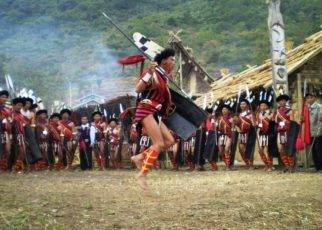The Hornbill Festival (in the Indian state of Nagaland) begins in the first week of every December and lasts up to four days. It takes place in the main arena of the Naga Heritage Village complex, Kisama (some thirty-odd kilometres outside of Kohima Town, the state capital of Nagaland).
Here, troupes of dancers and performers from the major Naga tribes come together to put on folk dances, war dances, folk songs and enactments of folk tales, tribal games and sports
India is famous for its cultural and religious festivals, like Holi (the festival of colours) and Diwali,(the festival of lights). These festivals have great religious significance for its participants.
Likewise, the Hornbill Festival has great cultural significance.The festival is named after the hornbill bird, a bird which has featured in many Naga myths and folktales. But there’s a greater reason for its significance.
For the Nagas, the festival is a meaningful reminder of their tribal customs and stories. Ruled by British and later, Indian administrators and converted to Christianity by American Baptist or Jesuit missionaries, Naga tribes have since struggled to preserve their pre-Christian culture and identity. Their modern political history has been marred by separatist insurgency, Indian military rule and inter-tribal conflicts.
So by contrast, the festival represents a chance for all Nagas to appreciate their culture as a whole, and to see its value to their sense of an ethnic identity.
For interstate and foreign visitors, it’s a colourful, vibrant introduction to this still-unknown tribal culture. Nagaland, and the other six states in India’s North-East, has remained somewhat of a restricted zone for Indian and international travellers. It is only in the last few decades that the Central government has relaxed these restrictions, in response to the ongoing peace negotiations between it and the guerrilla groups. This has allowed more tourists to come in and explore Nagaland, and their first stop is usually the Hornbill Festival, where they encounter in living colour the people of the Naga Hills.





